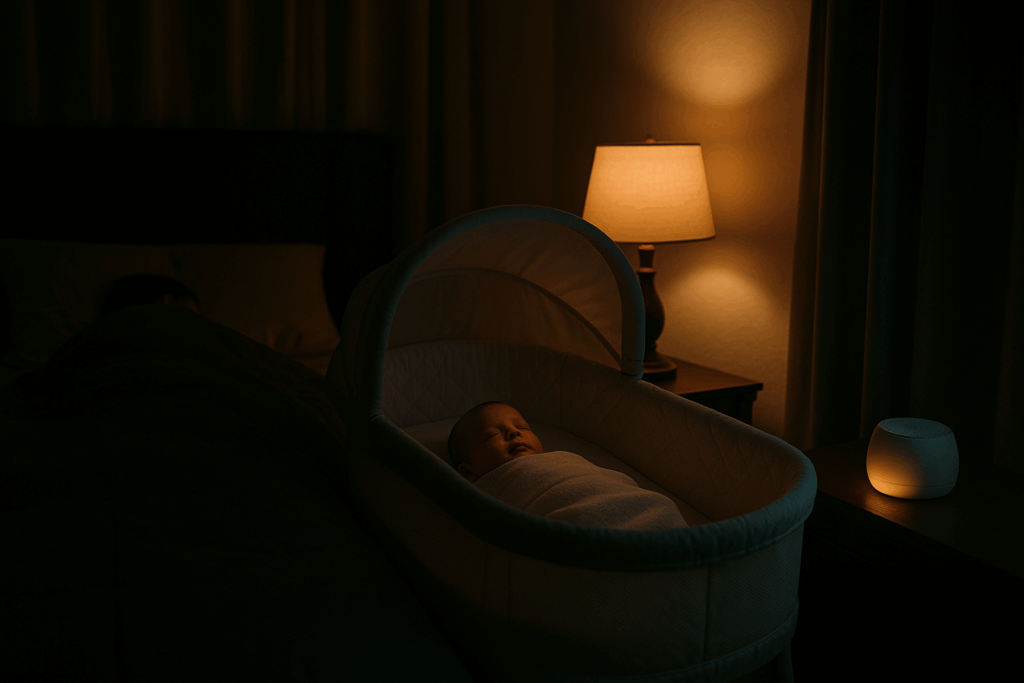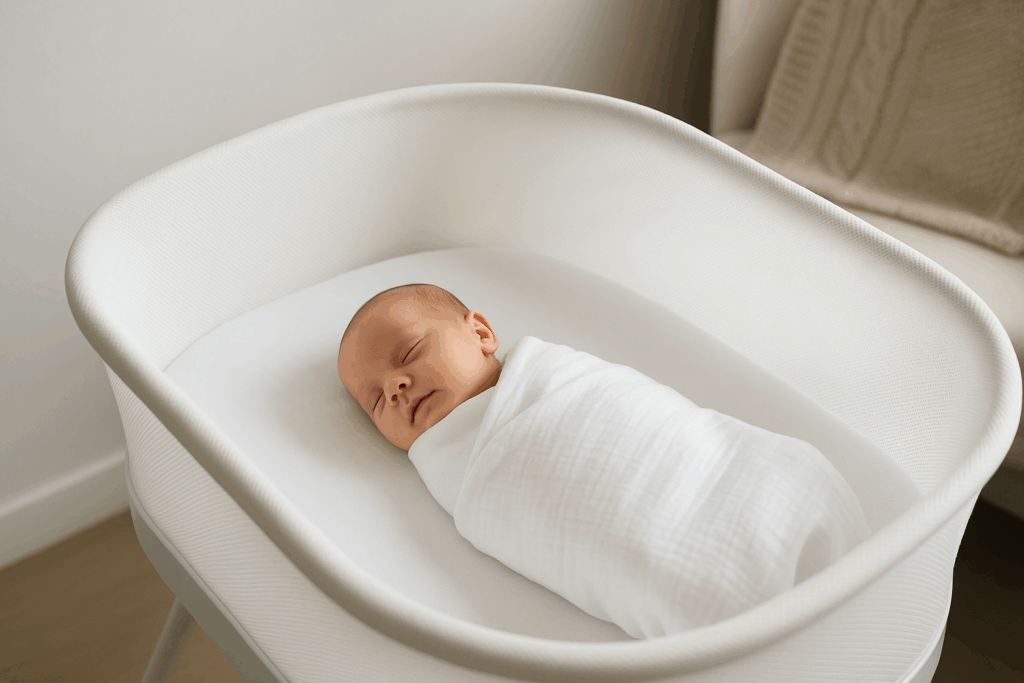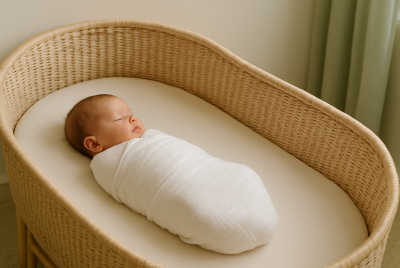How to Get Newborn to Sleep in Bassinet: Real Parent Solutions That Work
We may earn a commission for purchases made using our links. Please see our disclosure to learn more.
If you’re reading this at 2 AM, bouncing your baby for the hundredth time, you’re not alone. One of the most common struggles for new parents is figuring out how to get a newborn to sleep in a bassinet—instead of your arms, your bed, or anywhere but where you want! Sleep deprivation can make every night feel endless, but there are gentle, proven ways to help your newborn settle down and drift off in their own safe sleep space.
Let’s walk through why babies resist bassinets and what you can do—starting tonight—to create peaceful nights for your whole family.
Introduction: The Bassinet Struggle Is Real
Picture this: your baby falls asleep on your chest, warm and peaceful. But the second you try to lay them in the bassinet, their eyes pop open and the crying begins again. Sound familiar?
Many parents face this nightly challenge, and the frustration is real. But with a little understanding and some practical steps, you can teach your baby to sleep soundly in their bassinet. All you need is a little perseverance and the appropriate strategy.
Understanding Why Newborns Resist the Bassinet
To help your baby adjust, it’s important to know why they fight the bassinet in the first place. Here are some common reasons:
- Separation Anxiety: After nine cozy months in the womb, the outside world feels big and strange.
- Startle Reflex: Babies have a strong “Moro” reflex that makes their arms flail when laid down.
- Temperature Change: Your body is warm; the bassinet may feel cold.
- Scent: Your scent is soothing, but the bassinet doesn’t smell like you.
- Noise or Light: Newborns are sensitive to sudden noises or changes in lighting.
Understanding these can help you pick the right strategy for your baby.

10 Proven Ways to Get Your Newborn Sleeping in the Bassinet
Here’s how real parents have turned things around—no sleep training required.
1. Create a Womb-Like Environment
Your baby spent months surrounded by gentle movement, warmth, and muffled sounds. Try to mimic that:
- Use a white noise machine or app set to “heartbeat” or “rain.”
- Keep the bassinet close to your bed for comfort.
- Gently sway or rock before laying baby down.
2. Follow a Simple Bedtime Routine
Babies love predictability. Even something as simple as “change diaper, swaddle, feed, cuddle, bed” can work wonders. The routine signals that sleep is coming.
3. Perfect the Swaddle
A snug, safe swaddle recreates the secure feeling of the womb and helps prevent startling awake. Be sure to use a lightweight, breathable fabric, and stop swaddling when your baby shows signs of rolling.
4. Use White Noise Wisely
White noise masks household sounds and mimics what your baby heard in the womb. Place the machine near the bassinet but not inside it, and keep the volume low.
5. Choose the Right Time
Babies that are overtired have trouble falling asleep. Keep an eye out for signs of sleepiness, such as yawning, eye rubbing, or looking off into space. Try to put your baby down before they get overtired.
6. Try Gentle Rocking Before Laying Down
A few minutes of rocking or bouncing in your arms can help your baby drift into a deeper sleep. Then, gently lower them into the bassinet.
7. Warm the Bassinet (Safely)
Sometimes, the shock of cold sheets wakes a baby up. Try placing a warm (not hot) water bottle on the mattress for a few minutes before bedtime—but always remove it before laying your baby down.
8. Keep the Room Dim and Calm
A dark room signals it’s time to sleep. Use blackout curtains or a small nightlight if needed.
9. Mind the Startle Reflex
Lay your baby down feet-first and keep your hand on their chest for a few moments to help them feel secure.
10. Offer Comfort While Staying Safe
If your baby fusses, try shushing softly, patting gently, or offering a pacifier. Resist picking them up immediately—sometimes a little reassurance is all they need.
Top 3 Products for Easier Bassinet Sleep
Sometimes, the right product makes all the difference. Here are a few favorites that parents swear by:
- HALO SleepSack Swaddle
A safe, easy-to-use swaddle that helps babies feel snug without coming loose in the night. - Hatch Rest Sound Machine
Combines white noise, gentle night light, and even a time-to-rise function as your baby grows. - Philips Avent Soothie Pacifier
Trusted by hospitals, these pacifiers can help soothe fussy newborns to sleep.
Troubleshooting: What If My Baby Still Won’t Sleep in the Bassinet?
If you’ve tried everything and your newborn still won’t sleep in the bassinet, take a deep breath. Sometimes, all it takes is time and persistence.
- Try daytime naps in the bassinet so your baby gets used to it when everyone is less stressed.
- Switch up your routine or try a new swaddle or white noise sound.
- Check for discomfort: Wet diaper? Gas? Too hot or cold?
- Ask for help. Every parent needs a break—don’t hesitate to reach out to your support network.
Most importantly: This phase will pass. Your baby will learn, and you will sleep again.

Scientific Insights: Safe Bassinet Sleep and Non-Pharmacological Soothing
Recent scientific research offers valuable guidance for parents seeking safe and effective ways to help their newborns sleep in a bassinet.
A study on bassinet use and Sudden Infant Death Syndrome (SIDS) highlights the importance of proper bassinet safety and room-sharing. According to this research on bassinet use and SIDS, placing your baby in a bassinet with a firm mattress and without extra bedding significantly reduces the risk of sleep-related incidents. The study further underscores that most infants benefit from using a bassinet in the first two months, provided parents follow updated safety guidelines. For more practical tips, you can also review these baby sleep safety guidelines to make sure your setup meets the latest recommendations.
Meanwhile, another comprehensive review explores the effectiveness of non-pharmacological sleep interventions for newborns. In particular, the “Five S’s” method and the innovative SNOO Smart Sleeper bassinet have been shown to make a real difference. The review on the Five S’s and SNOO Smart Sleeper found that gentle rocking, swaddling, and white noise—core components of both the Five S’s and the SNOO—can help soothe fussy babies and encourage longer, more restful sleep. Notably, the SNOO also helps keep babies safely on their backs, aligning with safe sleep recommendations.
Together, these findings reinforce what many parents discover firsthand: creating a safe, comforting environment and using proven soothing techniques can help your newborn sleep better in their bassinet, while giving you peace of mind.
Conclusion: Finding Your Family’s Rhythm
If you take nothing else away from this guide, remember this: You’re not doing anything wrong. Getting a newborn to sleep in a bassinet can be tough, but small, consistent changes really do add up. Trust yourself, trust your instincts, and don’t be afraid to try different approaches until you find what works for you and your baby.
Better nights are possible—and soon, these sleepless days will be a memory.
FAQs About Newborn Bassinet Sleep
Q1: Is it safe for my newborn to sleep in a bassinet all night?
A: Yes, as long as the bassinet meets current safety standards and there’s nothing but a fitted sheet—no pillows, toys, or blankets.
Q2: How long should a newborn sleep in a bassinet?
A: Most babies sleep in a bassinet for the first three to six months or until they start to roll over or push up.
Q3: What if my newborn only sleeps while being held?
A: This is common! Gradually introduce the bassinet for short naps, and use soothing techniques to help the transition.
Q4: Should I let my baby cry it out in the bassinet?
A: Newborns are too young for cry-it-out methods. Focus on gentle soothing and comfort instead.
Q5: What causes my infant to awaken the moment I put them down?
A: It’s often the startle reflex or a change in temperature. Try swaddling and warming the sheet beforehand.
If you found these tips helpful, share this article with a friend or save it for those tough nights. You’ve got this!




